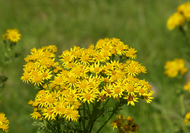Most horse owners in the UK are aware that the common weed known as Ragwort (botanical name Jacobaea vulgaris) is bad news if it rears its bright yellow head anywhere close to grazing land. Not all, however, know exactly why this nasty invader is so dreaded, and how to deal with it.
It’s certainly not the case that your horse will keel over and die instantly if he swallows a clump of Ragwort. The weed is, however, toxic to horses (and other grazing animals) because of the alkaloids it contains, which can have a cumulative effect and result in potentially irreversible deadly liver disease.
The good news is that horses – unless they are very hungry – are unlikely to choose to eat Ragwort because of its unpleasant bitter taste. The bad news is that Ragwort is actually more lethal dead than alive, because it loses this unpalatable taste when it dries but retains its toxicity, and can thus pose a danger if it ends up in hay.
The BHS (British Horse Society) and other equestrian organisations involved in horse welfare therefore recommend that keepers of horses be extremely vigilant in recognizing and eradicating this plant scourge which can spring up and spread quickly in fields, paddocks and yards across the countryside.
The effects of Ragwort poisoning in Horses
Damage to the liver of a horse from eating Ragwort is insidious, whether it is triggered by eating a one-off large amount or imbibing small amounts over a long time. Sadly, the effects may not be obvious until it is too late to prevent serious damage that is beyond treatment and euthanasia is the only option.
When the symptoms do appear, they are heartbreakingly horrible. World Horse Welfare describes them as follows:
“First they may become lethargic or behave abnormally. They can develop photosensitisation, where areas of pink skin become inflamed and painful when exposed to sunlight, like serious sunburn. They can also lose significant amounts of weight, even though they may be eating well.
Eventually they may go blind, have to fight for breath, start to wander or stagger or stand pushing their head against the wall. The symptoms and subsequent death can come about so quickly that owners have sometimes found their horse dead without warning.”
No-one wants to see their precious steed suffer such a fate, so when it comes to Ragwort it is obviously better to be safe rather than sorry.
How to Recognise Ragwort 
Every keeper of horses should make it a point to become familiar with the growth stages of the dreaded weed, so as to be able to be rid of it well before it gains its very strong foothold in the vicinity of the animal.
You are unlikely to spot the plants until they become visible as tight rosettes of dark green oval-shaped, serrated leaves, in early spring. At this stage the roots are already well-developed and tenaciously tough.
Ragwort stays in this rosette stage through the first annual season of its growth, eventually flowering the following year.
The distinctive bright yellow daisy-like flowers on long stalks are very prolific during the second year of the Ragwort’s cycle, from around June through to October. At this point the plant is well established, with deep, extensive roots, and at the end of the flowering season in late September is ready to spread its many thousands of seeds far and wide.
Ragwort seeds can lay dormant for years, so it is important to eradicate the plant before it produces its offspring.
Eradicating Ragwort
It is unlikely you will remove all traces of Ragwort from an infested area with just one operation. It may take several efforts annually to rid your pasture of this stubborn intruder.
The best time to tackle it is in the rosette stage, before it is allowed to flower and produce more seeds.
However, and at whatever growth stage, you tackle the plant make sure no dead parts of it are left in the area because dead Ragwort is just as toxic to horses as is the live plant.
You can use a commercial herbicide such as Barrier H Ragwort herbicide to spray on the plants, then dig up any surviving or re-occuring plants using a specially designed Ragwort fork, making sure all the roots are removed.
A new product on the market for Ragwort control, which is proving popular because it contains no chemicals or herbicides, is Freestep's Ragroot BioSpray. This product is designed to be sprayed into the hole after you have pulled up a Ragroot plant to eliminate the opportunity for regrowth and re-mineralise the soil.
Ploughing or mowing will not eradicate the weed, and may just result in spreading it further.
When using a herbicide make sure you follow the directions on the container with great care. Don’t put the horses back in the area until you are sure all dead matter has been cleared away.
Always wear gloves when handling Ragwort, and dispose of dead or dying Ragwort remains as quickly as possible, preferably (if your property allows for it) with controlled burning. Make sure no seeds get dispersed in the disposal process. If all else fails call in a professional waste disposal company to get rid of it for you. It is vital to remember that horses should not be allowed near dried out Ragwort!

Help!
If you feel overwhelmed by a Ragwort infestation, you can contact DEFRA for help and advice:
Telephone 03459 33 55 77 or email defra.helpline@defra.gsi.gov.uk.
The British Horse Society has a useful online “toolkit” about dealing with Ragwort.



